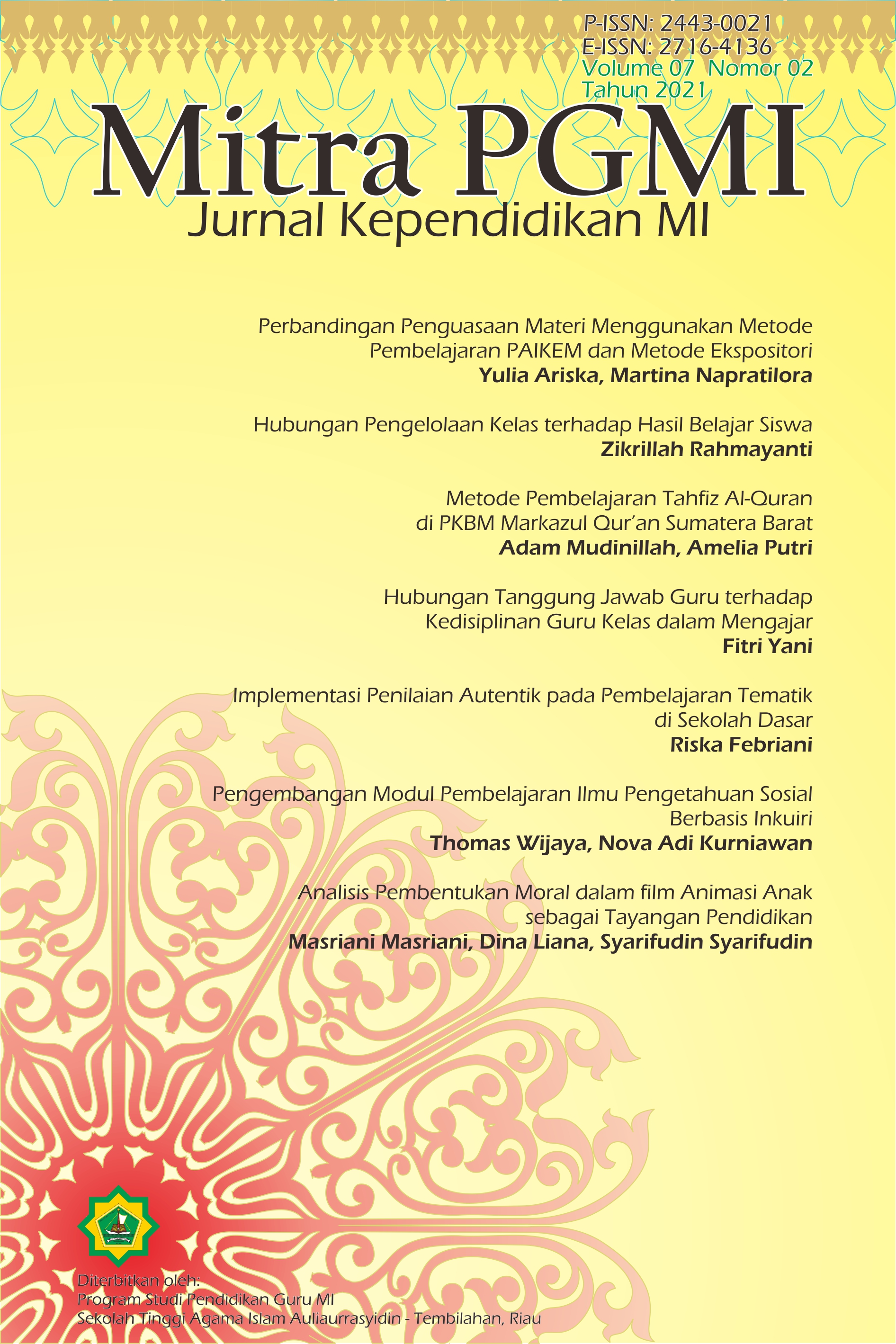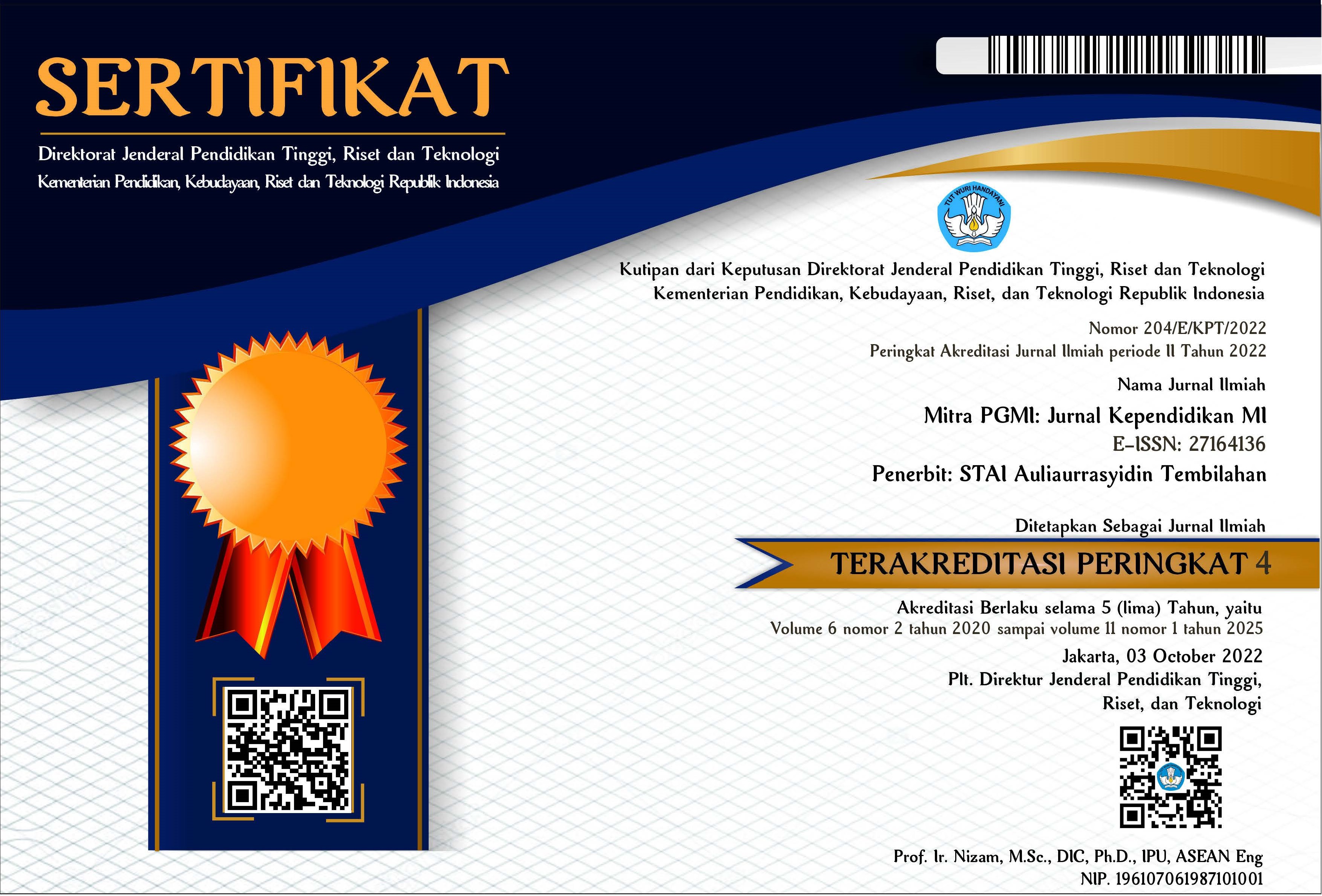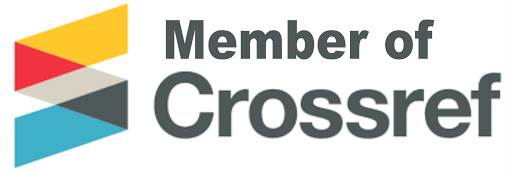Hubungan Tanggung Jawab Guru terhadap Kedisiplinan Guru Kelas dalam Mengajar
DOI:
https://doi.org/10.46963/mpgmi.v7i2.366Keywords:
Responsibility, Discipline, Classroom TeacherAbstract
The purpose of this study was to determine the relationship of teachers' responsibility to classroom teachers' discipline. This type of research was quantitative correlational research. The population was six teachers at the State Elementary School of 012 Parit 7 Sungai Pinggan, Batang Tuaka District. The data in this study were collected using questionnaires and documentation techniques. Furthermore, the collected data was analyzed using the Product Moment Correlation formula. The results of the study indicated that there was a positive, and significant relationship between teachers' responsibility and classroom teachers' discipline. Through data analysis on the two variables, the output of the correlation coefficient was 0.582, meaning that the level of strength of the relationship between the teachers' responsibility and teachers' discipline was 0.582 or moderately strong. It means that the relationship (correlation) was significant at a significance value of 0.05. Thus, there was a positive and significant relationship between the teachers' responsibility to the classroom teachers' discipline in teaching.
Downloads
References
Amirul Hadi, dkk. (2005). Teknik Mengajar Secara Sistematis. Jakarta: Rineka Cipta.
Arikunto, S. (2006). Prosedur penelitian Suatu Pendekatan Praktik. Jakarta: Rineka Cipta.
Arikunto, S. (2006). Prosedur Penelitian Suatu Pendekatan Praktik. Jakarta: Rineka Cipta.
Bafadal, I. (2003). Peningkatan Profesionalisme Guru Sekolah Dasar. Jakarta: Bumi Aksara.
Bungin, B. (2010). Metodologi Penelitian Kuantitatif. Jakarta: Prenada Media Grouf.
Cholid Narbuko, Abu Ahmad. (2005). Metodologi Penelitian. Jakarta : Bumi Aksara.
Danim, S. (2011). Pengmbangan Profesi Guru. Jakarta: Kencana.
Darmadi, H. (2012). Kemampuan Dasar Mengajar (Landasan dan Konsep Implementasi). Bandung: Alfabeta.
Herwati dan Afrizal. (2008). Ringkasan Statistika Pendidikan. Tembilahan: STAI Auliaurrasyidin.
Irawan, I. (2019). Upaya Kepala Madrasah Dalam Mendisiplinkan Guru di MTs Baitul Kirom Lampung Tengah. Lampung: Skripsi.
Iskandar. (2010). Metodologi Penelitian Pendidikan. Jakarta: Gaung Persada Press.
Mulyasa, E. (2000). Standar kompetensi Sertifikasi Guru. Bandung: Remaja Rosdakarya.
Musfiqon, M. (2012). Metodologi Penelitian Pendidikan. Jakarta: Prestasi Pustakaraya.
Nurlasmi. (2018). Upaya Meningkatkan Kedisiplinan Guru. Surabaya: Kresna Bina Insan Prima.
Qomar, M. (2008). Pesantren dari Transformasi Metodologi Menuju Demokrasi Institusi. Jakarta: Erlangga.
Riduwan. (2008). Belajar Mudah Penelitian untuk Guru-Karyawan dan Peneliti Pemula. Bandung: Alfabeta.
Riduwan. (2008). Belajar Mudah Penelitian untuk Guru-karyawan dan Peneliti Pemula. Bandung: Alfabeta.
Riduwan. (2008). Belajar Mudah Penelitian untuk Guru-Karyawan dan Peneliti Pemula. Bandung: Alfabeta.
Riduwan. (2008). Mudah Penelitian untuk Guru-Karyawan dan Peneliti Pemula. Bandung: Alfabeta.
Sagala, S. (2013). Kemampuan Guru dan Tenaga Kependidikan. Bandung: Alfabeta.
Sudarwan. (2011). Pengembangan Profesi Guru. Jakarta : Kencana.
Sugiyono. (2011). Metode Penelitian Kuantitatif, Kualitatif dan R & D. Bandung: Alfabeta.
Sukardi. (2005). Metodologi Penelitian Pendidikan. Jakarta: Bumi Aksara.
Downloads
Published
Issue
Section
License
Copyright (c) 2021 Fitri Yani

This work is licensed under a Creative Commons Attribution-ShareAlike 4.0 International License.
Authors who publish with this journal agree to the following terms:
1. Copyright on any article is retained by the author(s).
2. The author grants the journal, right of first publication with the work simultaneously licensed under a Creative Commons Attribution shareAlike 4.0 International License that allows others to share the work with an acknowledgment of the work’s authorship and initial publication in this journal.
3. Authors are able to enter into separate, additional contractual arrangements for the non-exclusive distribution of the journal’s published version of the work (e.g., post it to an institutional repository or publish it in a book), with an acknowledgment of its initial publication in this journal.
4. Authors are permitted and encouraged to post their work online (e.g., in institutional repositories or on their website) prior to and during the submission process, as it can lead to productive exchanges, as well as earlier and greater citation of published work.
5. The article and any associated published material is distributed under the Creative Commons Attribution-ShareAlike 4.0 International License








2.png)


